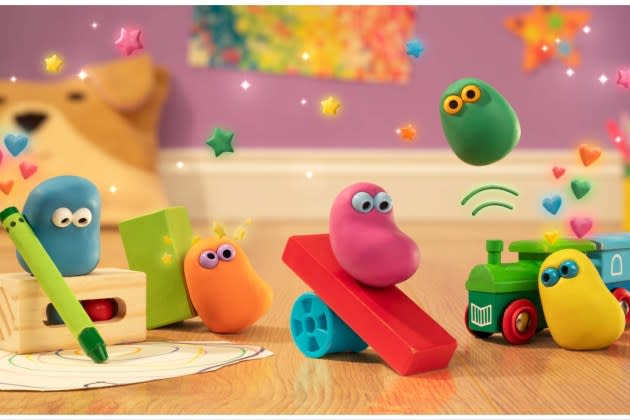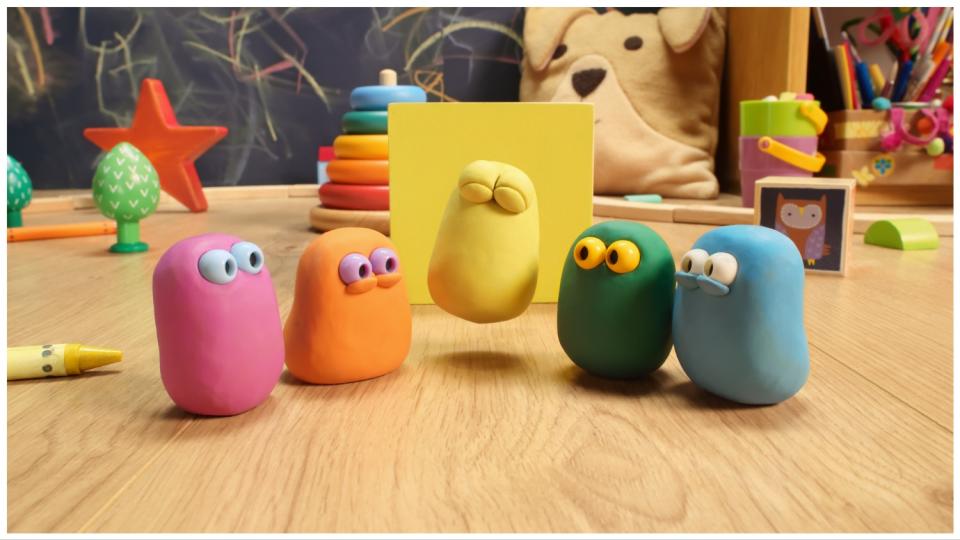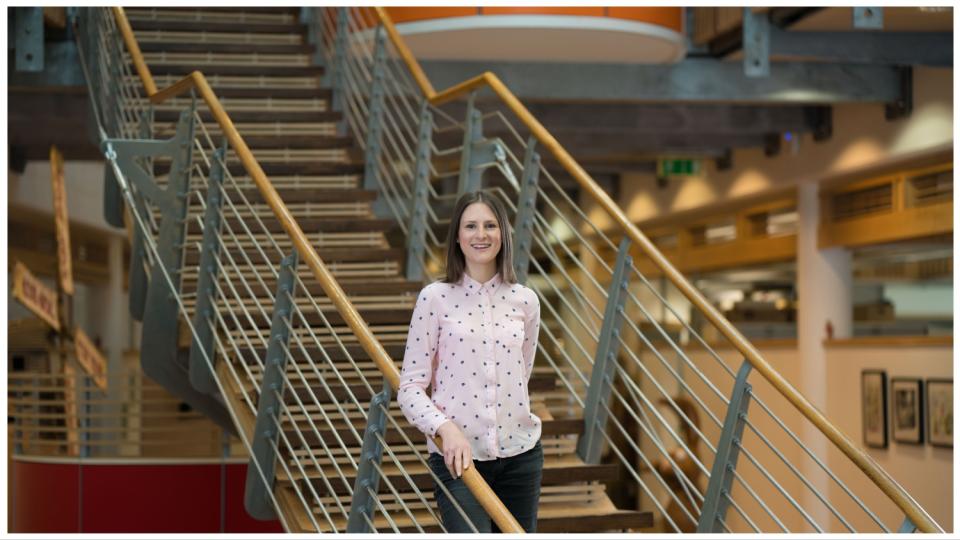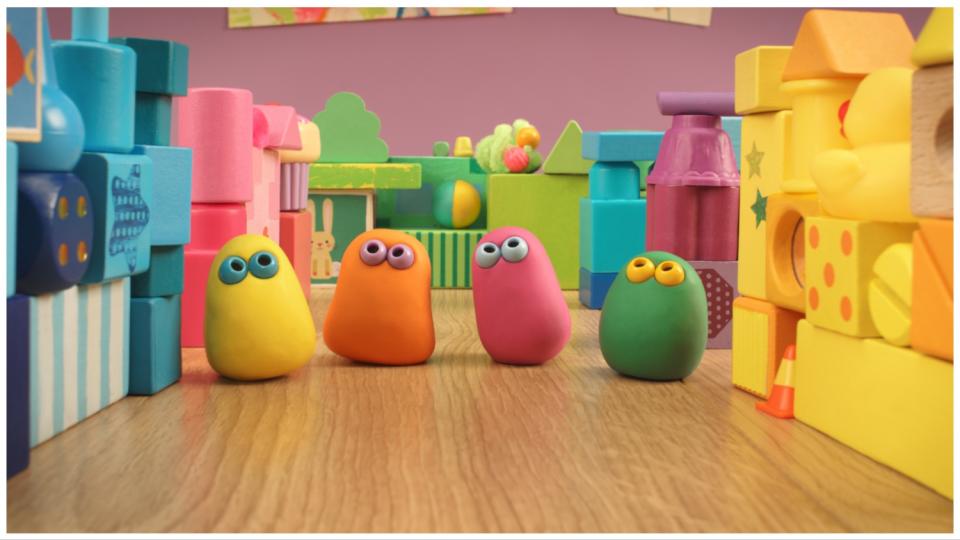Aardman Spins Toddler Babble Into Comedy Gold With ‘The Very Small Creatures’: ‘They Are Little Creatures, but Big Characters’
- Oops!Something went wrong.Please try again later.
- Oops!Something went wrong.Please try again later.
- Oops!Something went wrong.Please try again later.
- Oops!Something went wrong.Please try again later.
- Oops!Something went wrong.Please try again later.

For more than 40 years, Aardman Animations has been producing classics like “Wallace & Gromit,” “Chicken Run” and “Shaun the Sheep.” Now, following in the footsteps of pioneers such as Peter Lord, David Sproxton and Nick Park, new recruits have come on board at the company’s headquarters on Spike Island in the port city of Bristol, in the West of England, replenishing its creative treasure chest.
Variety steps along the gangplank to meet some of the more recent additions to the crew: Dan Ojari and Mikey Please, the creators of Oscar-nominated “Robin Robin” (see here); kids’ comedy series “Lloyd of the Flies” creator and director Matthew Walker, and co-director and voice director Jane Davies (see here); and Lucy Izzard, the creator, writer and director of “The Very Small Creatures,” a BAFTA nominated preschool series (see below).
More from Variety
“The Very Small Creatures,” commissioned by U.K. pay-TV operator Sky, is a stop-motion series for one to three-year-olds. The show follows five toddler-like clay creatures who explore a child’s play area when no one’s around. The characters originated in the early eighties as a colorful childlike crowd that interacted with Lord and Sproxton’s classic character Morph. In “The Very Small Creatures,” these creatures take center stage. Two seasons have appeared on Sky, and although a third season has yet to be greenlit, Izzard is working on additional stories for the show. She has also been writing for “Shaun the Sheep.”

Izzard studied illustration at Kingston University but “kept being drawn to storyboarding, telling stories and making short films,” she tells Variety via Zoom from her home in Bristol, where her cat occasionally jumps on the call, or, more accurately, the keyboard.
Although Izzard had almost no technical animation training, her animated graduation film, “Tea Total,” won the BBC Three New Talent Award in 2005.
Early influences included the surreal humor of creative geniuses such as Edward Lear, Ronald Searle and Spike Milligan, as well as British comedian and artist Vic Reeves. “I’m just interested in silliness, basically,” Izzard says. “If I could make a career out of comedy and telling funny stories… I mean, I have to pinch myself every day. You know, I do this for a job. And I feel like I’m just doing what my kids do: I play around with little characters and make up stories.”
After working as a freelance illustrator, animator and animation director for several years, Izzard joined Aardman in 2011 as an animator, working mainly on short films. A seismic change in her life, when she and her wife became the parents to two children, led to the creation of “The Very Small Creatures.” “I had a certain confidence becoming a mum, and it wasn’t just about me anymore, and not just from a financial perspective. My career is about creating something that I can enjoy with my children,” she says.
During a quiet period at Aardman, Izzard worked at the local university, which gave her access to the university library where she watched countless old episodes featuring Morph. This led her to pitch Aardman the idea of giving the toddler characters from “Morph” their own show.
Her pitch, delivered to Lord, who created “Morph” with Sproxton, Sarah Cox, Aardman’s executive creative director — IP development, and Merlin Crossingham, who has voiced and directed the “Morph” series since 2014, was that the show would be a cross between “Friends” and “Purple & Brown,” an Aardman show created by Rich Webber.
Whereas “Morph” is for kids of all ages, her show is aimed at toddlers. “I specifically pitched a younger pre-school show because there wasn’t enough good-quality content that I wanted my one-year-old or my three-year-old to watch, and so, I wanted it to be relatable to them and their age.”
“Also, I totally wanted it to be different from ‘Morph.’ I didn’t want it to be about tricking each other, with an antagonist, such as Chas, coming in and making Morph’s life more difficult. ‘Morph’ is funny — my son, now he’s older, loves it — but I wanted a different show. I thought you could do comedy with kindness. My dad always used to say: Don’t laugh at someone, laugh with them. And that’s what I’ve had in mind for every aspect of this series.”

She expected resistance to the idea of a “Morph” spinoff but was pleasantly surprised. “It felt like such an obvious thing. I remember pitching it to Merlin, Peter and Sarah, and I was so sure they were going to say to me, ‘Oh yes, we thought of that. We can’t do it for this reason, this reason and this reason.’ But they didn’t. They turned around and said: ‘Yeah, it’s a great idea. Go develop it.’ And so, that’s what I did.”
After writing the scripts for the first season, Izzard put together an animatic for one episode, “Boing.” She was assisted by Will Becher as Izzard had only ever done 2D and had never tried stop-motion. She also made LAVs (Live Action Videos), a reference video. “You see it play out and you watch it, and you see if it’s going to work, and then you get a sense of what the show is,” she says. All of her communication with Becher was done at home on Zoom due to the pandemic lockdown.
With this package of material, they were able to pitch Sky, which had already screened the latest iteration of “Morph,” titled “The Epic Adventures of Morph.” The pay TV operator greenlit it in December 2020, and they went into production in February 2021, with the first season comprising 20 episodes of three minutes each.

In the show, there are no adult characters, only the toddler-like creatures. “It’s just toddlers. We’re in their world. We’re with them. We’re experiencing it all from their perspective. The adults don’t play a role,” Izzard says.
Toddlers are inherently funny, she says, “because everything is so new, every experience is new. So, they find a camera or a microphone, and we know what to do with them, we know how it’s going to react, and they don’t, and there’s a lot of comedy in that.”
“There’s just a lot of comedy in toddlers. We’re very self-aware, and toddlers aren’t very self-aware. We’re more subtle with the way that we act. Toddlers aren’t. They act with their whole body. When they have a tantrum, they’re on the floor. They’re moving. They’re kicking their legs and waving their arms all over the place. They’re big characters. They are little creatures, but they’re big characters.”
Izzard borrowed from the behavior of her children and that of the kids of friends and colleagues for storylines and character traits. One such example was for the character called Blue (the other characters are called Pink, Orange, Yellow and Green), who “loves cats and likes to meow, and that whole side of his personality came from our producer on season one whose little boy used to meow to give away his location when playing hide and seek.”

She also used to show her children the animatic, and observing them helped her get the pacing of the show right. “If you watch little kids watching something their eyes move more slowly and they need a slower edit to absorb everything that’s going on, but not only absorb it, to enjoy the action, turn to their sibling, laugh about it, share that moment, and then go back to the screen and be ready for the next thing to happen. So, even just seeing how my kids watch the animatic, I could see what we needed to do to the edit.”
“I watch my kids play games. When I played hide and seek with my daughter, when she was just under two, she would stick her head in the potty, ducking down, completely visible, but she couldn’t see us, so she thought she was hiding. And that’s something that we included in the hide and seek episode in season one. It’s just this lovely little funny thing. And it’s everywhere. It’s in every aspect of the series.”
She didn’t rely on the expert advice of developmental psychologists but drew on conversations with the staff of her kids’ nursery. These included topics such as: “What was their emotional intelligence? What were the things that they were learning? How to recognize their own emotions. How to manage their own emotions. How to respect other people’s emotions.”
She adds: “It wasn’t about academic learning. It’s all about the emotional side. It’s about acknowledging and accepting feelings and emotions, and also, at that age, learning about their own physicality and the physicality of the world around them.”
Referring to one of the objectives of the show, Izzard says: “We want to model good behavior. We want to show the audience a good way to respond to a certain situation.”
While working on “The Very Small Creatures,” Izzard wrote a bible for the show. “There are rules to the world. There are do’s and don’ts, things that we’ll never do… the characters will never morph, but they are malleable, they’re made of clay, they’re going to be manipulated by their environment,” she explains. “And that’s really fun: When one sticks their bottom in a star shape and comes out with a starry bottom, that’s brilliant! And they fling themselves around. We have lots of slapstick. That’s the humor that works for this age group. And we stay in the realms of the real world. We’re down there on the floor with the children in their space, in a space that is familiar to them. We don’t ever go into the realms of magic. In one of our episodes, we look at one of the characters who has a very vivid imagination to the point where that imagination scares them. And we’ve got to be really clever with the way that we say: ‘This is their imagination,’ and make that really clear to the audience.”
As well as “Morph,” another influence on Izzard’s show was “Creature Comforts,” in which Park took vox-pop interviews with real people and then matched the audio with clay characters in a stop-motion animated series.
The voices in her show are of real toddlers, not actors. “It’s got to be authentic,” she says. “Sound is so important. Toddlers can hear themselves. Not only is it really cute and joyful hearing their voices, it’s nice for the toddlers to hear themselves and hear the way they speak on television. It’s authentic, it’s genuine. If you get an adult to do that it’s more contrived and artificial.”
Children’s voices were put in at the animatic stage. “It was a labor of love, because it was a huge job to interview loads of children and collect all of these clips, and then cut them down and label them by delivery, by emotion, by whatever was descriptive of the dialogue,” she says of the “toddler babble” that came out of the various methods the team came up with to elicit the dialogue. “It’s almost impossible to direct kids, but you can instigate games, you can have certain props and books, and try and get them to mimic you. I remember playing hide and seek with a kid for 20 minutes, and all I’m getting from their voice is ‘Coming, ready or not’ in their lovely toddler babble. So, it’s a difficult one. This isn’t the easiest way of doing it, but the authenticity of their voices is one of my favorite aspects of the whole series.”
Having the voices recorded before the episode is animated helps inspire the animators. “We have all of our labelled clips, a script, a narrative, and we know what we’re boarding out. But we don’t know what they’re going to say, and sometimes that voice will inspire a piece of beautiful animation on the floor. And it’s really great to have those voice clips in there before it gets animated, because that’s when the animator is going to give them the most expression.”
Izzard adds that all of her own films have been based around authentic voices, not the work of actors. “I like the spontaneity. I like the fact that you don’t always know what you’re going to get and half the time you get something much better than you could have ever predicted.”
Best of Variety
'House of the Dragon': Every Character and What You Need to Know About the 'Game of Thrones' Prequel
Sign up for Variety’s Newsletter. For the latest news, follow us on Facebook, Twitter, and Instagram.

